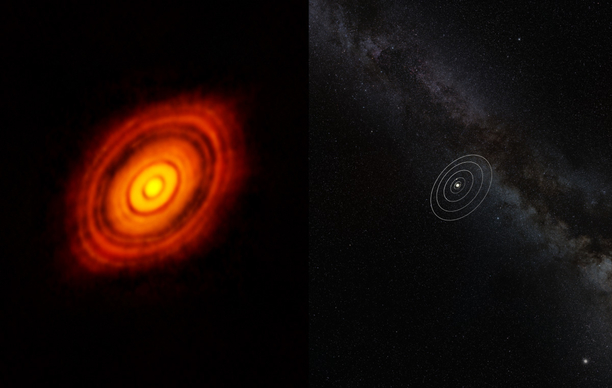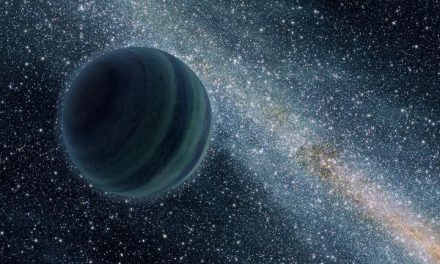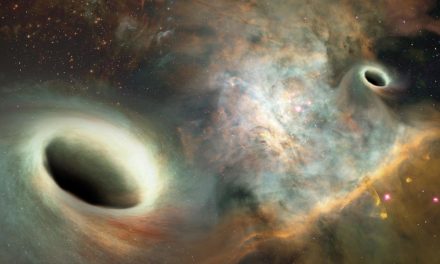
The protoplanetary disk orbits HL Tauri, a million-year-old sunlike star located approximately 450 light-years from Earth in the constellation of Taurus, dwarfs our solar system (right). The image taken by the ALMA array, showcases a series of concentric and bright rings, separated by gaps — features astronomers have struggled to explain until now. Credit: ALMA (ESO/NAOJ/NRAO)
It is theorized that a star and its planets form out of a collapsing cloud of dust and gas within a larger cloud called a nebula. With Hubble and the Kepler space telescope astronomers have been observing thousands of planets in orbit around other stars. An issue to understanding formation of new planets is that many of those we have observed are ancient and orbiting around stars a few billion years old. With what scientists have observed in our galaxy, it was expected that emerging planetary systems required at least one giant planet, the size of or larger than Jupiter, the gas giant in our solar system. However the majority of these observed exoplanets fall short into a category called super-Earths, that is heavenly bodies with a mass somewhere between Earth and Neptune.
To learn more about the birth of new planets astronomers are now studying protoplanetary disks, that consist of humongous clouds of interstellar gas and dust. At the center of these protoplanetary disk shines a relatively young, few million year old, star, which condenses the clouds of interstellar gas and dust under the effects of its gravity until it collapses into a swirling disk. These swirling disks are seen around stars that are 1 million years old, but are not observed in stars that are 10 million years old. In the time between, the disk’s material likely goes into forming planets, while the rest gets sucked onto the star or blown away by stellar radiation.
So while protoplanetary disks have been spotted comparatively close to the Earth, it is still exceedingly hard to really see any planets that may be organizing inside. Instead, astronomers have relied on features such as gaps and rings (see photo above) to surmise the existence of planets. In a new study soon to be published in the Astrophysical Journal, lead author Ruobing Dong, the Bart J. Bok postdoctoral fellow at the University of Arizona’s Steward Observatory proffers a scenario that was formerly regarded impossible: that a super-Earth can carve out multiple gaps in disks.
The images of HL Tauri and TW Hydrae made with ALMA, the Atacama Large Millimeter/submillimeter Array in Chile, made in 2014 and 2016, respectively, have uncovered the most exquisite intricacies so far in any protoplanetary disk. And they show some features that are difficult, if not unimaginable, to explain with current models of planetary formation. Dong says: “Among the gaps in HL Tauri and TW Hydrae revealed by ALMA, two pairs of them are extremely narrow and very close to each other.” While previous models could explain large, single gaps, the model created by Dong and his co-authors results in what the team calls synthetic observations — simulations that look exactly like what ALMA would see on the sky.

This new model takes into consideration the effects of dust as well as gas, resulting in a much more true to life picture. After 2,000 orbits, narrow gaps and multiple ring features emerge, just like those seen in actual observations such as the ones by ALMA. Credit: Shengtai Li and Ruobing Dong
The study, “Multiple Disk Gaps and Rings Generated by a Single Super-Earth,” shows that: “One super-Earth turned out to be sufficient to create the multiple rings and multiple, narrow gaps we see in the actual observations,” Dong states.










